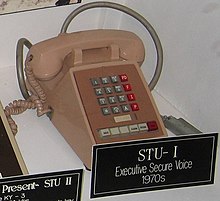
The STU-I, like its successors sometimes known as a "stew phone", was a secure telephone developed by the U.S. National Security Agency for use by senior U.S. government officials in the 1970s. [1]



The STU-I, like its successors sometimes known as a "stew phone", was a secure telephone developed by the U.S. National Security Agency for use by senior U.S. government officials in the 1970s. [1]



Communications security is the discipline of preventing unauthorized interceptors from accessing telecommunications in an intelligible form, while still delivering content to the intended recipients.

The Sturmgeschütz III assault gun was Germany's most-produced fully tracked armoured fighting vehicle during World War II, and second-most produced German armored combat vehicle of any type after the Sd.Kfz. 251 half-track. It was built on a slightly modified Panzer III chassis, replacing the turret with an armored, fixed superstructure mounting a more powerful gun. Initially intended as a mobile assault gun for direct-fire support for infantry, the StuG III was continually modified, and much like the later Jagdpanzer vehicles, was employed as a tank destroyer.

The National Cryptologic Museum (NCM) is an American museum of cryptologic history that is affiliated with the National Security Agency (NSA). The first public museum in the U.S. Intelligence Community, NCM is located in the former Colony Seven Motel, just two blocks from the NSA headquarters at Fort George G. Meade in Maryland. The motel was purchased, creating a buffer zone between the high security main buildings of the NSA and an adjacent highway. The museum opened to the public on December 16, 1993, and now hosts about 50,000 visitors annually from all over the world.
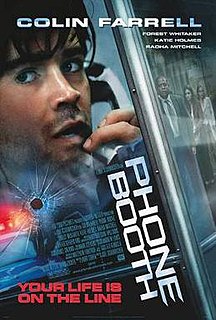
Phone Booth is a 2002 American black psychological thriller film directed by Joel Schumacher, produced by David Zucker and Gil Netter, written by Larry Cohen and starring Colin Farrell in the title role, Forest Whitaker, Katie Holmes, Radha Mitchell, and Kiefer Sutherland. In the film, a malevolent hidden sniper calls a phone booth, and when a young publicist inside answers the phone, he quickly finds his life is at risk. The film received generally positive reviews from critics and was a box office hit, grossing $97 million worldwide against a production budget of $13 million.

STU-III is a family of secure telephones introduced in 1987 by the NSA for use by the United States government, its contractors, and its allies. STU-III desk units look much like typical office telephones, plug into a standard telephone wall jack and can make calls to any ordinary phone user. When a call is placed to another STU-III unit that is properly set up, one caller can ask the other to initiate secure transmission. They then press a button on their telephones and, after a 15-second delay, their call is encrypted to prevent eavesdropping. There are portable and militarized versions and most STU-IIIs contained an internal modem and RS-232 port for data and fax transmission. Vendors were AT&T, RCA and Motorola.

Secure Terminal Equipment (STE) is the U.S. government's current, encrypted telephone communications system for wired or "landline" communications. STE is designed to use ISDN telephone lines which offer higher speeds of up to 128 kbit/s and are all digital. The greater bandwidth allows higher quality voice and can also be utilized for data and fax transmission through a built-in RS-232 port. STE is intended to replace the older STU-III office system and the KY-68 tactical system. STE sets are backwards compatible with STU-III phones, but not with KY-68 sets.
The National Security Agency took over responsibility for all U.S. Government encryption systems when it was formed in 1952. The technical details of most NSA-approved systems are still classified, but much more about its early systems have become known and its most modern systems share at least some features with commercial products.
The Secure Communications Interoperability Protocol (SCIP) is a US standard for secure voice and data communication, for circuit-switched one-to-one connections, not packet-switched networks. SCIP derived from the US Government Future Narrowband Digital Terminal (FNBDT) project. SCIP supports a number of different modes, including national and multinational modes which employ different cryptography. Many nations and industries develop SCIP devices to support the multinational and national modes of SCIP.
SAVILLE is a classified NSA Type 1 encryption algorithm, developed in the late 1960s, jointly by the Government Communications Headquarters (GCHQ) in the UK and the National Security Agency (NSA) in the US. It is used broadly, often for voice encryption, and implemented in many encryption devices.
The KSD-64[A] Crypto Ignition Key (CIK) is an NSA-developed EEPROM chip packed in a plastic case that looks like a toy key. The model number is due to its storage capacity — 64 kibibits, enough to store multiple encryption keys. Most frequently it was used in key-splitting applications: either the encryption device or the KSD-64 alone is worthless, but together they can be used to make encrypted connections. It was also used alone as a fill device for transfer of key material, as for the initial seed key loading of an STU-III secure phone.

St. Thomas University (STU) is a private Catholic university located in Miami Gardens, Florida. The university’s College of Health Sciences & Technology, College of Law, College of Business and Biscayne College offer 61 undergraduate and graduate degree programs, and post-graduate certificate programs on-campus and online. As of 2021, the university enrolls 5,921 students, which includes 1,797 undergraduate students; 1,498 graduate students; 780 law students; 62 non-degree students and 1,784 dual enrollment students. Over the years, the university's students have represented 45 states across the nation, and more than 70 countries.
The Automatic Secure Voice Communications Network (AUTOSEVOCOM) was a worldwide, switched, secure voice network for the United States Armed Forces, which was operational from the late 1960s to the end of the 1980s. It was closely related to the Automatic Voice Network or AUTOVON, which was the main non-secure switched telephone network for the military.

A secure telephone is a telephone that provides voice security in the form of end-to-end encryption for the telephone call, and in some cases also the mutual authentication of the call parties, protecting them against a man-in-the-middle attack. Concerns about massive growth of telephone tapping incidents led to growing demand for secure telephones.
OMNI is an encryption device manufactured by L-3 Communications. It adds secure voice and secure data to any standard analog telephone or modem connected computer.
Firefly is a U.S. National Security Agency public-key key exchange protocol, used in EKMS, the STU-III secure telephone, and several other U.S. cryptographic systems.
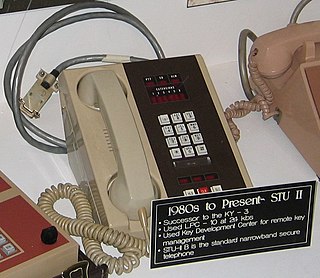
The STU-II is a secure telephone developed by the U.S. National Security Agency. It permitted up to six users to have secure communications, on a time-shared basis. It was made by ITT Defense Communications, Nutley, New Jersey. An OEM partner was Northern Telecom.
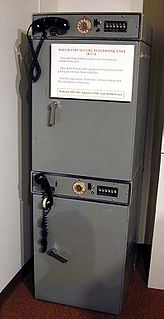
The KY-3 (TSEC/KY-3) is a secure telephone system developed by the U.S. National Security Agency in the early 1960s. It was one of the first widely accepted voice voice encryption systems. The "TSEC" prefix to the model number indicates NSA's Telecommunications Security nomenclature system.

The Navajo I is a secure telephone built into a briefcase that was developed by the U.S. National Security Agency. According to information on display in 2002 at the NSA's National Cryptologic Museum, 110 units were built in the 1980s for use by senior government officials when traveling. It uses the linear predictive coding algorithm LPC-10 at 2.4 kilobits/second.
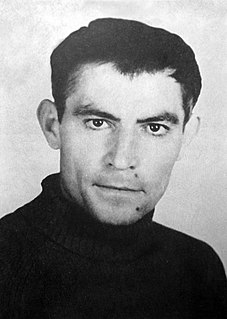
Vasyl Semenovych Stus was a Ukrainian poet, translator, literary critic, journalist, and an active member of the Ukrainian dissident movement. For his political convictions, his works were banned by the Soviet regime and he spent 13 years in detention until his death in Perm-36—then a Soviet forced labor camp for political prisoners, subsequently The Museum of the History of Political Repression—after having declared a hunger strike on September 4, 1985. On November 26, 2005, the Ukrainian president Viktor Yushchenko posthumously awarded him the highest national title: Hero of Ukraine. Stus is widely regarded as one of Ukraine's foremost poets.

The Maersk Alabamahijacking led to a series of maritime events that began on 9 April 2009, when four pirates in the Indian Ocean seized the U.S. cargo ship Maersk Alabama at a distance of 240 nautical miles southeast of Eyl, Somalia. The siege ended after a rescue effort by the United States Navy on 12 April.